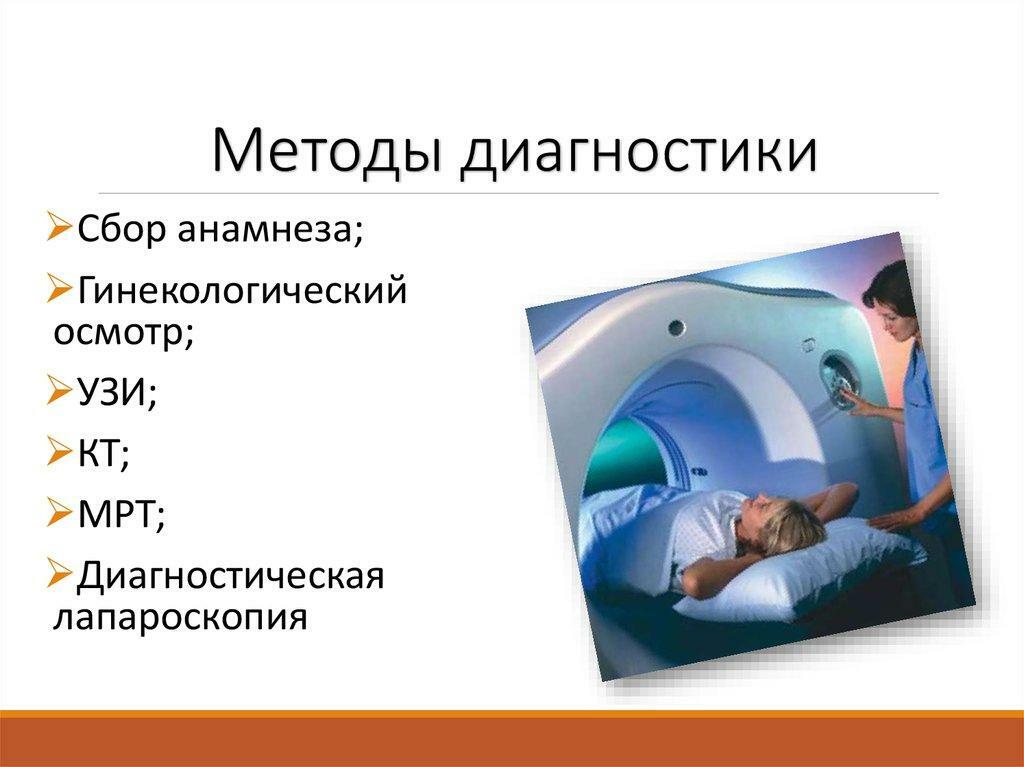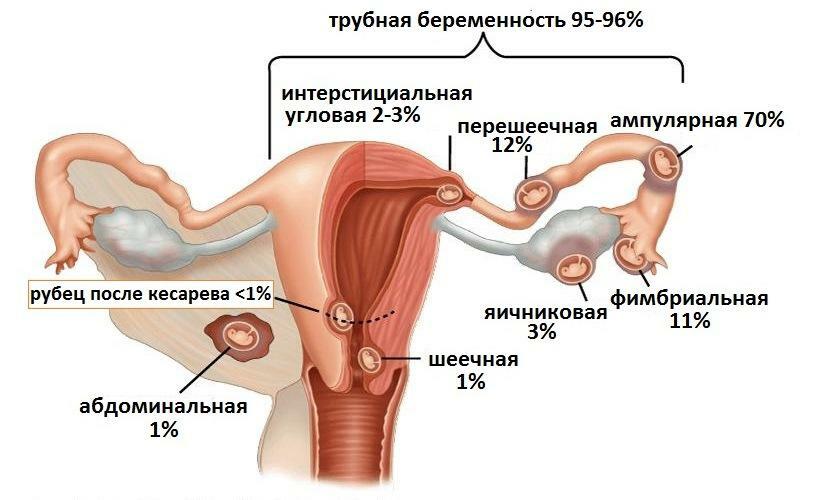Ovarian cyst is a pathological proliferation of organ tissues in the form of a sac or bubble filled with fluid. With a strong inflammation inside the pouch can accumulate pus, while the ovaries become very painful, the woman has symptoms of general intoxication. The size of the cystic formation can exceed the size of the ovary 5-6 times and reach up to 12-15 cm( in a healthy woman the ovaries have the dimensions of a walnut).There are cases when the cysts grew to 20-25 cm, and the process was not accompanied by severe symptoms and signs.
Cystic proliferation of ovarian tissues is rarely an isolated disease and occurs mainly against the background of other disorders, being their complication. The cause of the pathology may be hormonal fluctuations, gynecological diseases, inadequate thyroid hormone production by thyroid cells, abortions and miscarriages in the anamnesis. Most functional cysts do not need surgical treatment, but require constant monitoring. If the size of the formation is too large, a rupture can occur, which is dangerous with massive internal bleeding, so women should know how the pathology manifests itself and be able to distinguish it from other female diseases.
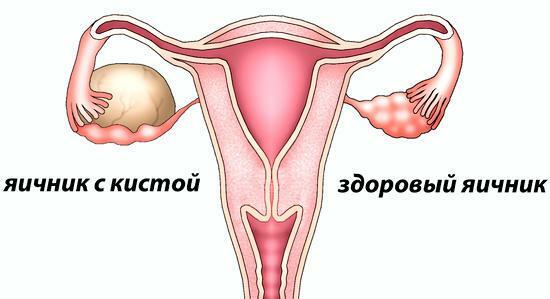
Symptoms of ovarian cysts, symptoms of
Content of material
- 1 What are cysts?
- 1.1 Video - What is the ovarian cyst? Do I need to delete it?
- 2 How to identify the cyst in the early stages?
- 3 Characteristic symptoms of ovarian cyst
- 3.1 Periodic increase in body temperature
- 3.2 Severe edema
- 3.3 Menstruation disorders
- 3.4 Changes in sexual life
- 3.5 Video - All about ovarian cyst
- 4 If the cyst has become inflamed
- 5 Cystic rupture rupture: how to recognize?
What are cysts?
More than half of women face the appearance of follicular cysts that form at the site of the follicle rupture during the ovulation period. The follicle is one of the structural components of the ovaries, consisting of the epithelial layer and connective tissue. Between them is an immature ovum, which grows during the menstrual cycle. During ovulation, the follicle walls burst, the ripe egg leaves the fallopian tube, and at the site of damage to the epithelial layer, a yellow body forms. The yellow body consists of glandular tissue, which is responsible for the synthesis of progesterone( a hormone necessary for implantation and fixation of the egg in the uterus and further development of pregnancy) and resolves itself for 2-3 months. If this does not occur, a follicular cyst is formed.
Usually, follicular cysts respond well to medical treatment and do not require surgical intervention, but with rapid growth, a woman will be prescribed ovarian laparoscopy. This is an operation that can be used for medical and diagnostic purposes. A hole is made in the abdomen of the woman, through which a laparoscope is inserted into the space of the small pelvis. If necessary during the procedure, the doctor can conduct the removal of the formation and send it for histological examination.
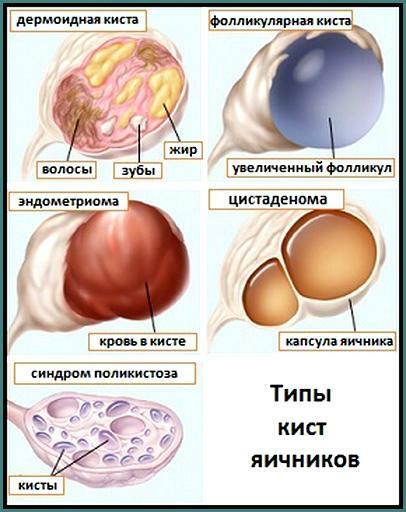
Types of ovarian cysts
Less common are other types of cysts, each with its own causes and differences in the treatment methods used. The table shows the most common of the cystic growths diagnosed in women of reproductive age.
| Kind of cyst | What is it like? |
|---|---|
| Dermoid | Congenital formation in ovarian tissues that forms during intrauterine development from the epithelial cells |
| Mucinous | Benign tumor with thin walls, inside of which is mucin - a turbid mucus secret. It is considered one of the most dangerous cysts requiring compulsory removal, as it is capable of regenerating into a malignant formation( ovarian cancer) |
| Paraovarial | Cavity formation that results from the upper part of the ovarian appendages |
| Endometrioid | Cystic overgrowth of the endometrium, which is a complication of endometriosis with active endometrial overgrowthlimits of the uterus( on the tissue of the ovary) |
Important! Hemorrhagic cysts, which occur when the blood vessels are broken and subsequently ruptured, and subsequently hemorrhage into the ovarian tissue, are also a danger for women. Pathology develops rapidly and is accompanied by an increase in temperature and a strong pain syndrome. The intensity of pain is usually very high, the character is cutting.
Video - What is the ovarian cyst? Do I need to delete it?
How to identify a cyst in the early stages?
In order to prevent the rapid growth of cystic education and timely the necessary therapy, it is important to know the initial signs and symptoms that can occur when the tumor is just beginning to grow. They are not specific and specific for this pathology, but in the aggregate should be an occasion to call a doctor and preventive examination.
With cysts of any type, the woman has a hormonal background that is disturbed, which affects the appearance and leads to certain changes in the body. A woman can suddenly gain excess weight, provided that she maintains her previous diet and physical activity level. Fat deposits are often accompanied by edema and are localized mainly in the abdomen and thighs.
At the same time, the activity of the hair follicles increases, which leads to intensive growth of hair on the body. Hair can appear even in places where it has never grown before: on the back, the lower abdomen, in the zone above the upper lip, in the temporal part of the face. On the legs, the hairs can become rougher and acquire a bright black color. An important point is that the hair grows very fast even after using the hardware methods of hair removal.
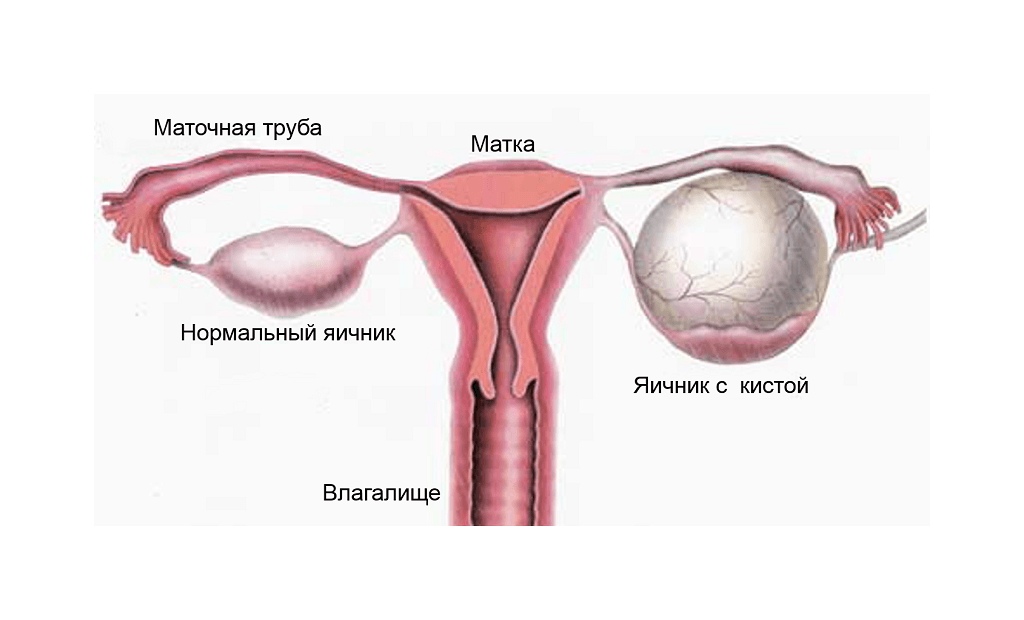
Ovarian cyst
Changes can touch and tone the voice: it becomes lower, the tonality also changes and becomes rude. Some women may have a hoarse, but this symptom is rare. Other early symptoms( before the onset of pain syndrome) accompanying the growth of cystic formations in the ovarian tissues include:
- frequent headaches;
- periodic attacks of hypotension;
- increase in the number of vaginal discharge in the period between menstruation;
- bloodsucking in the first half of the cycle;
- breast size reduction.
Please note! In most cases, the pain is initially absent, but sometimes a woman may experience minor pulling pains on one side of the abdomen, which can spread to the central part of the peritoneum, sacroculent and coccygeal zone and lower back. Pain has a weak intensity and is not associated with the menstrual cycle. What is the
ovarian cyst? The characteristic symptoms of the ovarian cyst
The most obvious symptom, indicating the possible growth of cystic cavities, is the pulling, intense pain in the lower abdomen. Usually it has a permanent character, but its severity can vary depending on the level of physical activity and other indicators. With a cyst, the pain syndrome becomes stronger during exercise, lifting weights, a few days before the onset of menstruation, with intimacy. The localization of pain can also be different: from the lower abdomen to the gluteus muscles and the coccyx region. Pain appears mainly from the side of the lesion, but with the onset of inflammation it can acquire a diffuse character.
This feature alone can not be considered typical for ovarian pathologies, therefore it is always evaluated in conjunction with other symptoms.
Periodic increase in body temperature
Body temperature in the ovarian cyst is almost never at a constant level. Often observed its fluctuations within the subfebrile condition( up to 37.2 ° -37.6 °).The basal temperature also rises, but it is not possible to evaluate this sign reliably, since a slight increase in the different phases of the menstrual cycle is considered the norm for healthy women.
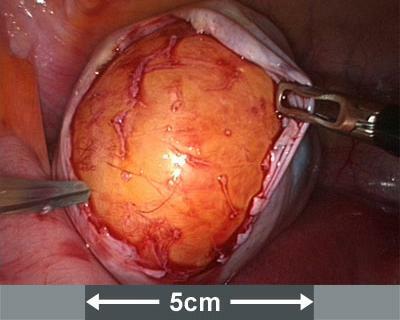
Ovarian cysts 5 cm in size
Severe edema
Puffiness often occurs in the subcutaneous fat, located in the abdomen. The abdomen itself appears enlarged due to fluid accumulation and tumor growth, with an increase usually observed only on one side. If the cyst is not inflamed, the stomach during palpation is painless, soft. Edema can also appear on the face, neck and extremities. Symptomatic therapy( use of decongestants and herbal dues), salt-free diet give the result, but it is usually short-lived.
Malfunctions of the menstrual cycle
At an early stage, when the tumor is only beginning to grow, this sign is weakly expressed or absent altogether. There may be minor fluctuations within 3-4 days, but such indicators are considered a variant of the norm, so they rarely cause an integrated survey.

Signs and symptoms of ovarian cysts in women
If the cyst is left untreated, other cycle disturbances may develop over time, which include:
- delay in menstruation for a long time( up to several weeks);
- profuse menstruation, which lasts more than a week( menorrhagia);
- increase in the number of precipitations between cycles and clotting during this period;
- soreness during menstruation;
- no monthly for a long time( more than six months).
Important! For any violations of the cycle, a woman should consult a doctor, as the cause may be serious hormonal disorders, in which the risk of infertility and gynecological diseases is more than 80%.
Changes in sexual life
In cysts of the ovary, a woman almost always experiences unpleasant and painful sensations during sexual intercourse. Their intensity can vary depending on the partner's activity, posture and other factors. Pain may also occur within 1-2 hours after intimacy, sometimes accompanied by a small amount of blood, dizziness and nausea. There is also a change in the sensitivity of erogenous zones, there are difficulties with the achievement of orgasm. The amount of vaginal lubricant drops sharply, sometimes the vaginal secretion does not stand out at all.
Video - All about the ovarian cyst
If the cyst has become inflamed
If the cystic build-up wall is broken, the microbes and bacteria that inhabit the mucous membranes of the urinary tract and pelvic organs can enter the cavity of the cyst. After entering the liquid environment, pathogenic microorganisms begin to multiply actively and release life-activities and toxins. The cavity of the cyst is filled with pus which, if ingested into the abdominal cavity, can lead to inflammation of the peritoneum and diffuse peritonitis, a deadly pathology( if the woman is not provided with surgical assistance on time).
To prevent this, you need to know the signs of inflammation of the ovarian cyst, which include:
- acute stitching or cutting pain in the lower abdomen from the pathological process;
- a sharp rise in temperature to 38.5 ° -39 °;
- abdominal tenderness in palpation;
- tension of abdominal muscles and bloating;
- painful defecation and urination;
- vomiting and severe nausea.
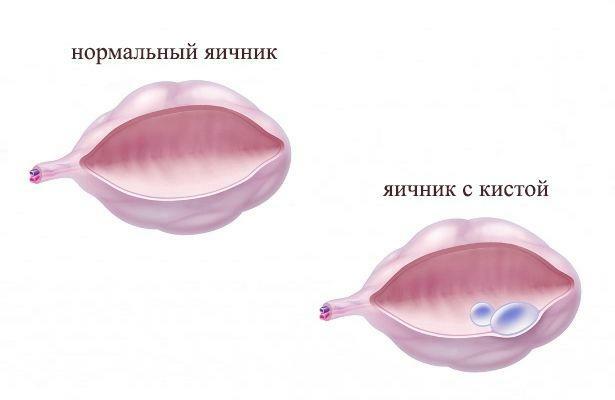
Ovary with a cyst from the inside
Important! If a woman observes signs of inflammation, it is necessary to contact a district gynecologist or hospital. Inflamed cyst can burst at any moment. This situation is dangerous peritonitis, sepsis, abscess and other deadly complications, so you can not ignore pathological symptoms. In addition, the inflamed cyst increases in size and begins to squeeze the surrounding organs, blocking the access of oxygen and nutrients.
Rupture of cystic growth: how to recognize?
If the situation has taken a critical course, and the cyst has burst, typical symptoms appear that can determine the severance or torsion of the formation. The woman has a sharp pain in the lower abdomen( "acute abdomen" syndrome), a large amount of mucus is released from the vaginal ways, the temperature rises to high marks. Perhaps a single vomiting, dizziness. In severe cases, a woman may lose consciousness. The skin becomes pale, sometimes there is a cyanotic appearance of certain areas( mainly on the face, abdomen and hands).Arterial pressure is reduced to critical values.
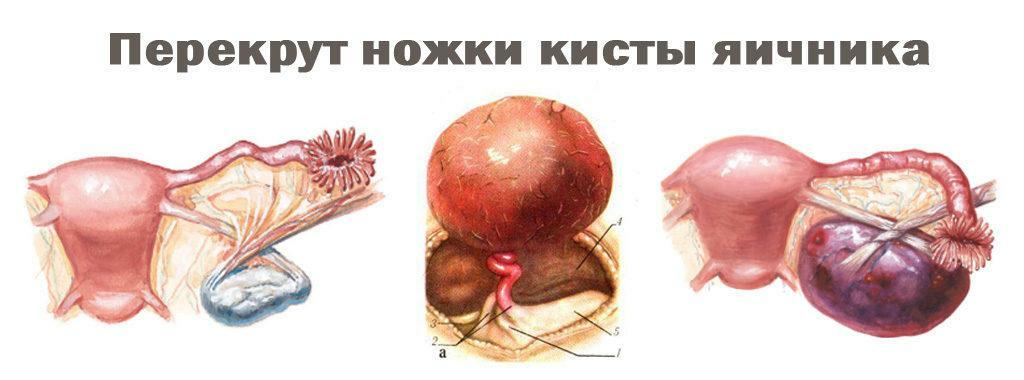
Torsion of the leg of the ovarian cyst
Important! With these signs, the woman should be urgently hospitalized in the gynecological department of the surgical hospital. Treatment for rupture or torsion of the ovarian cyst is only prompt.
Cystic formations in the tissues of the ovaries are quite a dangerous phenomenon with severe consequences, which can be avoided by contacting a specialist on time. Cysts of any type need constant observation. If necessary, the doctor will choose a medical or physiotherapy treatment or designate a surgical removal of the formation if the tumor does not respond to conservative therapy, or there is a high risk of inflammation and rupture, and also degeneration into malignant pathologies.


